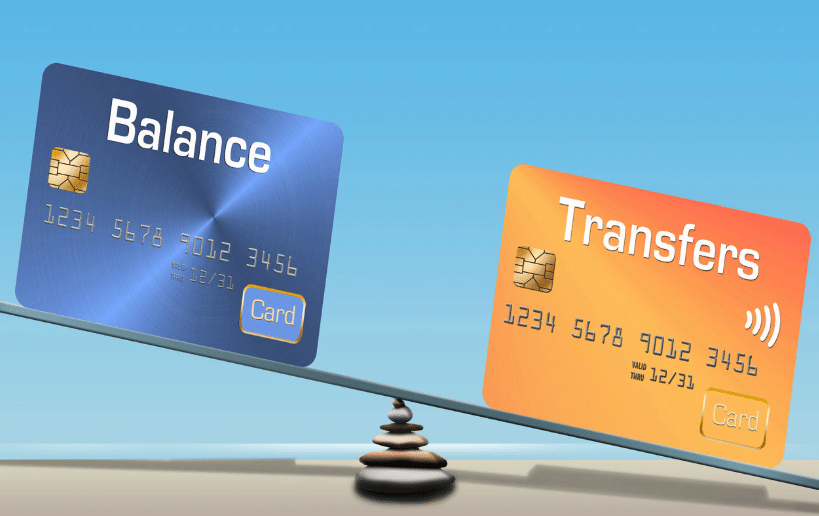
Best credit card balance transfer deals can be a lifesaver for consumers drowning in high-interest debt. These deals allow you to transfer existing balances from one credit card to another, often with a lower interest rate and an introductory period of 0% APR. This can significantly reduce your monthly payments and help you pay off your debt faster.
However, balance transfers aren’t always a silver bullet. There are important factors to consider, such as transfer fees, introductory periods, and your credit score. Understanding these factors and the terms and conditions associated with balance transfers is crucial for making informed decisions.
Understanding Balance Transfers
A balance transfer is a way to move debt from one credit card to another, often with a lower interest rate. This can be a great way to save money on interest charges and pay off your debt faster.
How Balance Transfers Work
A balance transfer is essentially a transfer of your outstanding balance from one credit card to another. You apply for a balance transfer credit card, and if approved, the issuer will pay off the balance on your old card. You then start making payments to the new card.
Terms and Conditions Associated with Balance Transfers
Balance transfers typically come with certain terms and conditions that you should be aware of. These can include:
- A balance transfer fee: This is a percentage of the balance you transfer, usually between 3% and 5%.
- An introductory interest rate: This is a low interest rate that is offered for a limited time, typically 6 to 18 months. After the introductory period, the interest rate will revert to the standard rate, which may be significantly higher.
- A minimum balance transfer amount: Some credit card issuers require you to transfer a minimum amount of debt, such as $500 or $1,000.
- A deadline for transferring the balance: You will have a certain amount of time to transfer the balance from your old card to the new card. This is typically within 30 to 90 days of opening the new account.
Identifying the Best Deals

Finding the best balance transfer offer requires careful consideration of various factors. By comparing different offers, you can maximize your savings and minimize the overall cost of transferring your debt.
Interest Rates
Interest rates are a crucial factor when evaluating balance transfer offers. Lower interest rates translate into lower interest charges, which can significantly impact the overall cost of your debt.
- Introductory APR: Many credit cards offer a promotional introductory APR for a specific period, usually 0% for 12-18 months. After the introductory period, the interest rate reverts to the standard APR.
- Standard APR: The standard APR is the interest rate charged after the introductory period expires. It’s important to compare the standard APRs of different offers to understand the long-term cost of transferring your balance.
Transfer Fees
Balance transfer offers often come with a transfer fee, which is a percentage of the amount you transfer. Transfer fees can range from 1% to 5% of the balance, so it’s important to consider their impact on your overall savings.
- Flat Fee: Some issuers may charge a flat fee instead of a percentage-based fee.
- Waived Fees: Certain credit card issuers may waive the transfer fee for a limited time or for specific cardholders.
Introductory Periods
The introductory period is the duration for which the promotional APR applies. Longer introductory periods provide more time to pay off your balance before the higher standard APR kicks in.
- Time to Pay Down: A longer introductory period allows you to make larger payments or focus on paying down your balance faster.
- Interest Savings: By taking advantage of a 0% APR introductory period, you can save significantly on interest charges.
Credit Score and Credit History
Your credit score and credit history play a crucial role in determining your eligibility for the best balance transfer offers.
- Higher Credit Score: Individuals with higher credit scores are more likely to qualify for lower interest rates and longer introductory periods.
- Good Credit History: A strong credit history demonstrates your responsible borrowing habits and makes you a more attractive candidate for lenders.
Utilizing Balance Transfers Strategically: Best Credit Card Balance Transfer Deals

Balance transfers can be a powerful tool for managing debt, but it’s essential to use them strategically to maximize their benefits. By understanding the nuances of balance transfers and following a structured approach, you can leverage them effectively to reduce interest payments and get out of debt faster.
Benefits of Consolidating Debt with Balance Transfers
Consolidating high-interest debt with balance transfers offers several advantages, making it a viable strategy for debt management.
- Lower Interest Rates: Balance transfers often come with introductory 0% APR periods, allowing you to save significantly on interest charges during this time. This can be a substantial advantage, especially if you have high-interest credit card debt.
- Simplified Payments: By consolidating multiple debts into one, you can simplify your payment schedule and avoid juggling multiple minimum payments.
- Improved Credit Score: Paying down your debt faster can improve your credit score, making it easier to qualify for loans and credit cards with better terms in the future.
Step-by-Step Guide to Effective Balance Transfer Utilization
To effectively utilize balance transfers for debt management, follow these steps:
- Identify High-Interest Debt: Begin by identifying your credit cards with the highest interest rates. These are the accounts you should prioritize for balance transfers.
- Compare Balance Transfer Offers: Research different credit cards that offer balance transfer options and compare their introductory APRs, transfer fees, and other terms. Consider factors like the length of the 0% APR period and any potential annual fees.
- Choose the Right Card: Select a card that offers the best combination of features, such as a long 0% APR period, low transfer fee, and favorable ongoing APR after the introductory period.
- Transfer Your Balance: Once you’ve chosen a card, initiate the balance transfer process. This typically involves contacting the new card issuer and providing the account details of the debt you want to transfer.
- Focus on Repayment: During the introductory 0% APR period, focus on aggressively paying down the transferred balance. Aim to repay the balance in full before the introductory period ends to avoid accruing interest at the regular APR.
- Avoid New Debt: Resist the temptation to rack up new debt on the transferred card during the introductory period. Focus on paying down the existing balance and avoid adding to your debt burden.
Avoiding Common Pitfalls
While balance transfers can be beneficial, it’s crucial to avoid common pitfalls that can negate their advantages:
- Ignoring the Transfer Fee: Balance transfers often come with a transfer fee, typically a percentage of the amount transferred. Consider the fee when comparing offers and ensure it doesn’t outweigh the savings from the lower interest rate.
- Missing the Deadline: Be mindful of the deadline for transferring your balance. If you miss the deadline, you’ll likely be charged interest at the regular APR.
- Not Paying Down the Balance: The primary goal of a balance transfer is to pay down the debt during the introductory period. If you don’t make substantial payments, you’ll end up paying more in interest over the long term.
- Overspending on the New Card: Avoid using the new card for new purchases, especially during the introductory period. This can lead to increased debt and negate the benefits of the balance transfer.
Available Resources and Tools
Navigating the world of balance transfers can be overwhelming, but fortunately, various resources and tools can help you make informed decisions and find the best deals. These tools can simplify the process and empower you to choose the most advantageous balance transfer options.
Reputable Websites and Resources
A wealth of information is available online to assist you in your search for the best balance transfer offers.
- Credit Karma: Credit Karma offers a free credit score and credit report monitoring service. They also provide a balance transfer calculator and compare credit card offers, including balance transfer options.
- NerdWallet: NerdWallet is a personal finance website that offers comprehensive credit card comparisons, including balance transfer offers. They provide detailed information on interest rates, fees, and other important factors.
- Bankrate: Bankrate is a financial website that specializes in comparing financial products, including credit cards. They offer a balance transfer calculator and a comprehensive list of balance transfer offers.
- WalletHub: WalletHub is a personal finance website that offers a variety of tools and resources, including credit card comparisons. They also provide a balance transfer calculator and a list of credit cards with balance transfer options.
- CreditCards.com: CreditCards.com is a website dedicated to credit cards, offering information on various topics, including balance transfers. They provide a comprehensive list of credit cards with balance transfer options and offer tools to compare offers.
Credit Card Comparison Table
Comparing different credit cards offering balance transfer options can be challenging. This table highlights the key features and benefits of popular balance transfer credit cards:
| Credit Card | Balance Transfer APR | Introductory Period | Annual Fee | Other Benefits |
|---|---|---|---|---|
| Chase Slate | 0% APR | 15 months | $0 | No foreign transaction fees |
| Citi Simplicity® Card | 0% APR | 18 months | $0 | No annual fee, no late fees |
| Discover it® Balance Transfer | 0% APR | 18 months | $0 | Cashback rewards, no annual fee |
| Capital One QuicksilverOne Cash Rewards Credit Card | 0% APR | 15 months | $0 | Cashback rewards, no annual fee |
| US Bank Visa® Platinum Card | 0% APR | 18 months | $0 | No annual fee, travel and purchase protection |
Tips for Finding the Best Balance Transfer Offers
Finding the best balance transfer offer depends on your individual needs and financial situation. Here are some tips to guide your search:
- Consider your credit score: Credit card issuers offer different APRs and terms based on your credit score. A higher credit score can qualify you for lower APRs and longer introductory periods.
- Compare balance transfer fees: Balance transfer fees can vary significantly between credit cards. Choose a card with a low or no balance transfer fee to minimize costs.
- Factor in the introductory period: The introductory period is the time during which you enjoy the 0% APR. Choose a card with a sufficiently long introductory period to allow you to pay down your balance before the standard APR kicks in.
- Evaluate other benefits: Some balance transfer credit cards offer additional benefits, such as cashback rewards, travel insurance, or purchase protection. These benefits can add value to your card.
- Read the fine print: Before you transfer your balance, carefully review the terms and conditions of the credit card agreement. Pay attention to any fees, penalties, or restrictions that may apply.
Case Studies and Examples

Real-world scenarios demonstrate how balance transfers can effectively reduce debt and provide financial relief. Understanding these examples helps illustrate the potential benefits and challenges associated with balance transfers.
Success Stories of Balance Transfers
The following examples highlight how consumers have successfully used balance transfers to their advantage:
- Consolidating High-Interest Debt: Sarah had accumulated $10,000 in credit card debt with interest rates ranging from 18% to 24%. She transferred her balances to a new card offering a 0% introductory APR for 18 months. This allowed her to save on interest charges and focus on paying down the principal balance. During the introductory period, she made more than the minimum payment, significantly reducing her debt. After the promotional period ended, she successfully secured another balance transfer offer with a lower interest rate, continuing her debt reduction journey.
- Taking Advantage of Low Introductory Rates: John had a balance of $5,000 on his credit card with a 19% APR. He found a balance transfer card with a 0% APR for 12 months. By transferring his balance, he saved on interest charges and was able to pay off the debt within the promotional period. This strategy allowed him to avoid accumulating more interest and gain control of his finances.
Challenges and Solutions Associated with Balance Transfers
While balance transfers offer significant potential for debt reduction, it’s essential to be aware of potential challenges and how to overcome them:
- Balance Transfer Fees: Many cards charge a fee for transferring balances, typically a percentage of the transferred amount. These fees can range from 3% to 5% and can impact the overall savings.
Solution: Compare balance transfer offers from different issuers to find those with lower fees or no fees. Consider transferring smaller amounts to avoid high fees. - Limited Time Offers: Introductory APRs for balance transfers are usually temporary, typically lasting 12 to 18 months. After the promotional period ends, the interest rate often reverts to a higher rate.
Solution: Develop a plan to pay off the balance before the promotional period ends. Consider making more than the minimum payment to accelerate debt repayment. - Credit Score Requirements: To qualify for balance transfer offers with attractive terms, you usually need a good credit score.
Solution: Improve your credit score before applying for balance transfer cards. This can involve paying bills on time, reducing credit utilization, and avoiding unnecessary credit inquiries.
Expert Insights on Managing Debt with Balance Transfers, Best credit card balance transfer deals
Financial experts recommend the following strategies for effectively managing debt using balance transfers:
- Thorough Research: Compare balance transfer offers from multiple lenders to find the best terms, including introductory APRs, fees, and transfer limits.
- Prioritize Debt Reduction: Focus on paying down the transferred balance as quickly as possible. Consider making more than the minimum payment to accelerate debt repayment.
- Avoid New Debt: Resist the temptation to accumulate new debt while using a balance transfer card. This can negate the benefits of transferring existing debt.
- Budgeting and Financial Planning: Create a realistic budget and stick to it. This will help you manage your finances effectively and avoid accumulating more debt.
Final Summary
Utilizing balance transfers strategically can be a powerful tool for debt management. By carefully evaluating offers, understanding the terms and conditions, and using balance transfers as part of a comprehensive debt reduction strategy, you can potentially save money and improve your financial well-being. Remember, it’s essential to be proactive in managing your debt and exploring all available options, including balance transfers, to find the best solution for your unique financial situation.
Commonly Asked Questions
What is the difference between a balance transfer and a cash advance?
A balance transfer is when you move an existing debt from one credit card to another, usually to take advantage of a lower interest rate. A cash advance, on the other hand, is when you withdraw cash from your credit card, typically incurring a high interest rate and fees.
How do I know if I qualify for a balance transfer offer?
Credit card issuers use various criteria to determine eligibility, including your credit score, credit history, and debt-to-income ratio. It’s best to check your credit score and review the specific eligibility requirements of the card issuer before applying.
Are there any hidden fees associated with balance transfers?
Yes, some balance transfers may have fees, such as a transfer fee (typically a percentage of the transferred balance) or a balance transfer processing fee. Be sure to read the fine print carefully and compare fees between different offers.

